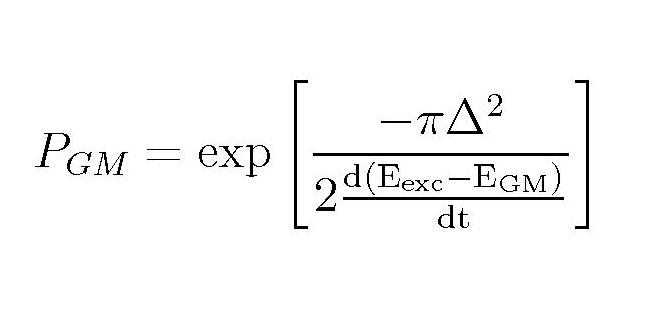zum Hauptkapitel Emerging Quantum Mechanics:
A fast variation of the transverse magnetic fields {hti} with time leads to a diabatic
development of the initial 4 qubit state, i.e. Landau-Zener transitions are
possible. If a two-level system starts at time t=0 in a given state, for instance
the global minimum state |GM>, the probability of finding it in the same state
at t->+\infty at the time of avoided crossing with an excited state |exc> is
(refs. \cite{landau,zener,dickson,amin}):

where \Delta is the tunnelling amplitude, which scales with the strength of the transverse
magnetic fields. \frac{\rm d (E{exc}-E{GM})}{\rm dt} is the rate of change of
the energy gap between the two states involved. Hence the probablity of a Landau-Zener
transition in the excited state increases when the transverse magnetic fields warrant
fast rate change of the energy gap. This can be seen in fig. where at the
time when the external magnetic fields are reduced to zero the first excited state
is occupied with nearly 17% probability. The choice of {hti} and their variation
with time lead to fast reduction of the energy gap between the first excited
and the global minimum state and the possibility for a diabatic time development.

Fig. 9: Landau-Zener transition between the global minimum state and the first excited
state for fast variation of the transverse magnetic fields {hti}. (a) Variation
with time of the transverse magnetic fields ht1 and ht2, much faster compared
to fig. 8. The rate of change of the energy of the low eigenstates is shown
in the uppermost plot on the right handside. (b) The plot in the middle shows the
variation with time of the occupation of the global minimum state and the first
excited state of the 4 qubit system. (c) The development with time of the occupation
summed up over basis states with spin 0 and spin 1 in the third qubit is displayed
in the last plot. The time on the horizontal axes is in arbitrary units.
The initial 4 qubit state with a dominating component from the |0111> basis state
shows a diabatic development and occupation of the first excited state of the order
of 17% at the time of crossing between the two states. A spin flip is also
observed (fig. c) and it is due to the fact that the main component of the first
excited state is the basis state |1101> with a flipped spin in the third qubit.
Experimentally LZ transitions have also been reported in molecular nanomagnets \cite{wernsdorfer}
and superconducting qubits \cite{izmalkov,oliver,sillamp,johansson}.

